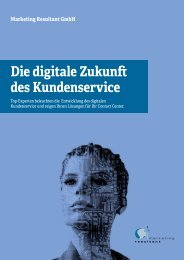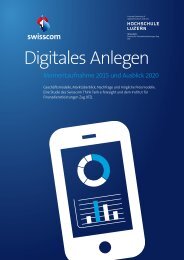Technology
tax14-technology-abo-version-lowres-151020
tax14-technology-abo-version-lowres-151020
You also want an ePaper? Increase the reach of your titles
YUMPU automatically turns print PDFs into web optimized ePapers that Google loves.
<strong>Technology</strong><br />
New external pressures<br />
Not only is technology stronger than ever, so is pressure to meet<br />
external demands for tax-related information and transparency.<br />
From OECD country-by country reporting and its Common<br />
Reporting Standard to the U.S. Foreign Account Tax Compliance<br />
Act (FATCA) to other legislation, governments across the globe are<br />
demanding unprecedented amounts of information.<br />
Moreover, disparate groups want different information and in<br />
different formats. Increased use of more powerful technology<br />
offers the only practical solution to meeting these demands and to<br />
enhancing the likelihood that the information provided to these<br />
disparate users will also be consistent.<br />
When companies aren’t prepared, significant disruptions can<br />
occur. For example, some countries in Latin America are now<br />
demanding an almost contemporaneous feed of company invoices<br />
and/or journal entries and trial balances, often in their own<br />
designated format.<br />
“It’s a real paradigm shift,” says Carolyn Bailey, EY’s Digital<br />
Government Tax Transformation Leader for Latin America. Very<br />
big companies doing business in Latin America are being refused<br />
refunds because they cannot provide data to the taxing authorities<br />
the way they’re being asked to provide it, she says “Companies in<br />
business for a century are having problems complying with the<br />
rules, as are new companies that are growing like crazy, but their<br />
systems, processes and data are just not ready to comply with<br />
these kinds of rules. And it is only likely to get worse.”<br />
The road to “outstanding”<br />
An outstanding tax department is one that is “absolutely<br />
integrated with the business and is leveraging technology to<br />
deliver value to the business,” says Albert Lee, EY’s Asia Pacific<br />
Key action points<br />
••<br />
Use data and analytics to drive value from <br />
the tax function.<br />
••<br />
Seek opportunities to use technology to reduce<br />
duplication of effort and manual entry errors.<br />
••<br />
Identify “quick win” opportunities for short-term<br />
progress that will also help to achieve<br />
longer-term progress.<br />
••<br />
Leverage systems already used by other areas<br />
of the business.<br />
••<br />
Develop an effective tax technology and <br />
data strategy and understand the “art of the<br />
possible” for your business, what needs to<br />
change and how.<br />
• • Use technology to integrate tax with the rest <br />
of the business.<br />
Tax Performance Advisory Leader. “A tax function whose data<br />
needs are well-integrated into the company’s financial systems <br />
can harness a huge pool of ‘big data’ in a strategic way,” he says,<br />
rather than gathering and manipulating scraps of data on a<br />
request-by-request basis. “This allows a tax function to spend<br />
much less time doing manual data-gathering and much more time<br />
doing analysis and driving value.”<br />
Many roads lead towards “outstanding.” The path can begin<br />
with individual projects to improve or replace a spreadsheet-based<br />
process all the way to a holistic, strategic redesign of a tax<br />
department’s function. The challenge for many companies, says<br />
Burman, is simply knowing where to begin. The first step might be<br />
an exploration of the tax department’s current frustrations or<br />
“pain points,” which can result in a number of short-term, “quick<br />
wins.” The next step is determining where the tax department<br />
should be to meet not only current demands but also those on the<br />
horizon and then developing a road map — an operational strategy — <br />
to make it happen. A technology strategy — the tools and systems<br />
intended to achieve the operational strategy — is a parallel process.<br />
It is critical, Burman, says, that the tax function integrates with<br />
the business as much as possible so that it will be involved in any<br />
systems design in order that the resulting systems will gather data<br />
needed for tax and in a way tax can use. Another common<br />
challenge, says Burman, is getting financial buy-in for the plans,<br />
which often means increasing the CFO’s awareness of how tax<br />
does what it does and the inherent level of risk in the tax area.<br />
Sally Stiles, Chief Tax Officer for Caterpillar, Inc., the world’s<br />
leading manufacturer of construction and mining equipment,<br />
diesel and natural gas engines, industrial gas turbines and<br />
diesel-electric locomotives, says, “If I had to tell a group of CFOs<br />
why they need to invest in their tax operations, I would say that<br />
they need to fully understand the amount of risk on their financial<br />
statements from tax, which is one of the biggest numbers on the<br />
financial statements.”<br />
Many of these risks are different from the past, she says.<br />
“There is an enormous amount of competition among countries to<br />
grab as much tax revenue as they can and this is not something<br />
that is going to go away. Companies will have to defend against<br />
unreasonable government positions and face the increase in data<br />
requests and resulting assertions, which are going to become<br />
more and more onerous from countries around the globe.”<br />
Transforming the tax department — the Caterpillar project<br />
Caterpillar is one global company that has commenced a strategic<br />
rethink of its entire tax function. What led the company to begin<br />
such a massive undertaking? “There wasn’t a single event that led<br />
us to transformation,” says Stiles. “However, there was a growing<br />
awareness that there weren’t enough of us to go around [and]<br />
there was a great need within our business to be better partners,”<br />
says Stiles.<br />
One of the key objectives for Caterpillar’s planned<br />
transformation − a long-term initiative still in progress − is to<br />
create more transparency over its global operations. As Stiles <br />
and her people looked at how to achieve this, “the first thing <br />
we realized is that we really didn’t have a strategy in place, so the <br />
first thing we did was to ask ourselves how the tax department<br />
should set up its operations to have a world-class view from <br />
a Caterpillar perspective.”<br />
22 EY – Tax Insights for business leaders №14







